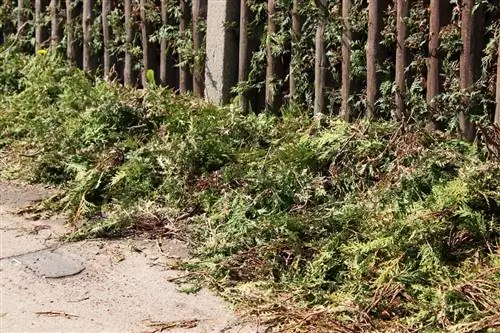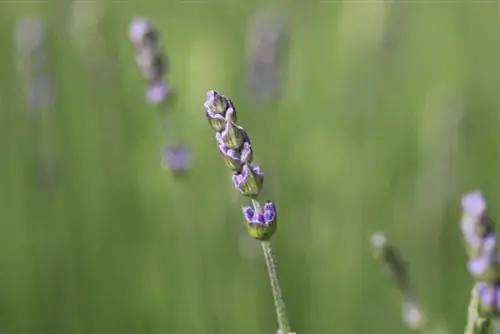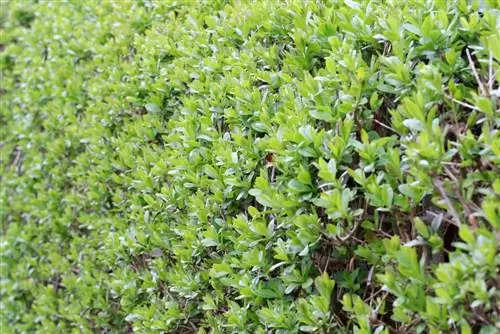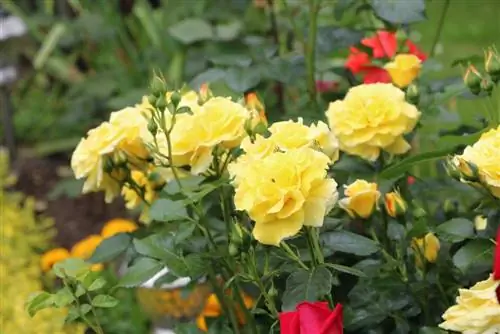- Author admin [email protected].
- Public 2023-12-17 03:39.
- Last modified 2025-06-01 06:48.
If solitary conifers or a conifer hedge are to be pruned, there is numerous contradicting information about the best time for the measure. This is confusing and can even harm the plants.
Time
Not only with conifer hedges, but also with solitary plants, it must be taken into account that the plants are habitats used by animals. Hedges and densely growing trees are used by birds, among other things, as protected nesting places. Nests are rarely immediately noticeable due to their growth before cutting.
The Federal Nature Conservation Act therefore prohibits radical offcuts in the period from January 1st. March to September 30th. However, careful care cuts, such as removing dead or damaged shoots as well as gentle shape cuts in which the length of the branches is only shortened slightly, are permitted all year round.
Note:
In many cases, especially with evergreen plants, it is not immediately obvious that a bird has chosen the plant as a breeding site. Even before care or shape cuts, an inspection should be carried out first and pruning should be postponed for a few weeks if necessary, even if it is permitted. However, the precautionary measure is to avoid disturbing the animals.
Necessity
Basically, this depends on the type of conifer and the legal requirements where you live. Dwarf forms take up little space and grow very densely. They are therefore also suitable for balconies and smaller gardens and generally work well without any waste.
For example, they include:
- Dwarf moss cypress, thread cypress - Chamaecyparis pisifera
- Dwarf pine, creeping pine - Pinus mugo pumilio
- Dwarf arborvitae, dwarf thuja - Thuja occidentalis
- Dwarf mussel cypress, Hinoki cypress - Chamaecyparis obtusa
- Dwarf juniper - Juniperus procumbens
- Creeping juniper - Juniperus horizontalis
- Sugarloaf spruce, ball spruce - Picea glauca
- Dwarf yew - Taxus cuspidata
- Swiss pine - Pinus cembra
Even with the slow-growing and small variants, there is a large selection and, thanks to breeding forms, numerous different growth forms and colors. This should be taken into consideration before deciding on conifers, because a common problem with conifers is that they quickly grow too large for the location.
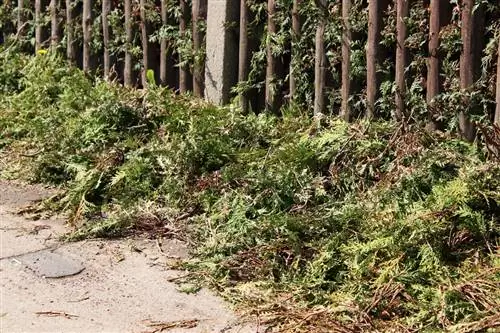
If they are only then cut, the shape can suffer greatly and holes can even appear. When cutting into old wood, these bare spots no longer close. The optics remain permanently impaired. In these cases, regular cutting of the young shoots is the better option.
Frequency
If a conifer needs to be trimmed to maintain the desired shape and size, one to two annual trimmings are recommended, depending on the rate of growth. Slow-growing varieties require annual pruning. Fast-growing variants, such as Thuja, should be cut back twice a year. Only the new, young shoots are removed.
This approach has several advantages. These include, among others:
- Protection of the plant due to low mass loss
- Cutting boundary clearly visible due to the color difference
- Shape and size are efficiently limited
- low effort
Tip:
If you are inexperienced with cutting conifers, you just have to pay attention to the color of the shoots. Young shoots are significantly brighter than older sections. If only these are cut off at the transition border, there is no risk of holes and bald spots.
Optimal timing
The first cutting of the year can be carried out on almost every conifer after the first shoots in spring until early summer. The maintenance measure should be carried out in June or early July at the latest. This means that the young shoots can be easily distinguished from the older branches and the risk of too radical pruning is significantly reduced.
The second cutting - if necessary - can be done in late summer or early autumn. Again, the timing should depend on when young shoots are available. The last opportunity to carry out a maintenance cut is at the end of September or beginning of October at the latest. Otherwise the conifer will not have the strength to adequately prepare for winter.
Ideal conditions
Whether the conifer is cut in spring, late summer or at both times - in any case, a suitable day should be chosen for the care measure. To avoid:
- Frost
- blazing sun
- high temperatures
- persistent drought
A dull, cloudy day with moderate temperatures is ideal. Because the interfaces burn and dry out very quickly, which can lead to unsightly brown tips and baldness.
Procedure and care
Cutting a conifer is actually easy, as long as the correct procedure is followed and the plant then receives appropriate care and attention. The following steps and factors should be considered:
Use clean cutting tool
In order not to transfer diseases to the fresh cuts, only clean cutting tools may be used. It is ideal to disinfect them before cutting.
Pay attention to the sharpness
So that the shoots are not crushed and drying is delayed or germs and pests can get in, the blades of hedge trimmers or secateurs must be sharp. If necessary, sharpening can be done again directly before cutting.
Pay close attention to transitions
The brighter, younger shoots give a good indication of where to cut. Branches that are already woody should not be injured, as this not only prevents them from sprouting again, but also creates brown or bare areas.
Plan for growth restriction
The top of conifers in particular should only be trimmed when the desired growth height has been reached. Because after shortening, there is no further upward growth. In order to still create an attractive look, care should be taken right from the start to cut the plant so that it tapers upwards. An exception here is the conifer hedge, where a clear line and dense growth are also visually appealing.
Cut regularly
Frequent and regular cuttings are important because only the young shoots can be cut off at a time without causing damage to the plants or risking brown sections and bald spots. It is therefore better to carry out a maintenance cut annually or twice a year than once every two years.
Observe subsequent fertilization
Even if the care or shape pruning is carried out and only a few shoots are lost, the strength and reserves of the plant are still reduced. The conifer should then be supplied with nutrients.

Suitable fertilizers after cutting include:
- Horn shavings or flour
- Compost
- Conifer fertilizer
- stable manure
- Primitive rock flour
Tip:
To avoid chemical burns and to promote an even distribution of nutrients, flushing watering is recommended. However, this should not cause waterlogging.
Pine clippings
Pine trees are an exception to the cuttings. The young shoots of this type of conifer can easily be pinched off with your fingers to maintain their shape or size. Blending is therefore not absolutely necessary. Removing the light green shoots can also be done gradually over several days or even weeks. This approach is generally gentler on the plant.

